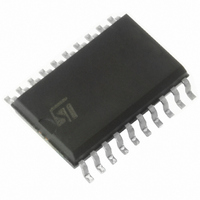ST7FDALIF2M6TR STMicroelectronics, ST7FDALIF2M6TR Datasheet - Page 92

ST7FDALIF2M6TR
Manufacturer Part Number
ST7FDALIF2M6TR
Description
IC MCU 8BIT 8K FLASH 20-SOIC
Manufacturer
STMicroelectronics
Series
ST7r
Datasheet
1.ST7DALI-EVAL.pdf
(171 pages)
Specifications of ST7FDALIF2M6TR
Core Processor
ST7
Core Size
8-Bit
Speed
8MHz
Connectivity
DALI, SPI
Peripherals
LVD, POR, PWM, WDT
Number Of I /o
15
Program Memory Size
8KB (8K x 8)
Program Memory Type
FLASH
Eeprom Size
256 x 8
Ram Size
384 x 8
Voltage - Supply (vcc/vdd)
2.4 V ~ 5.5 V
Data Converters
A/D 7x10b
Oscillator Type
Internal
Operating Temperature
-40°C ~ 85°C
Package / Case
20-SOIC (7.5mm Width)
Processor Series
ST7DALI
Core
ST7
Data Bus Width
8 bit
Data Ram Size
384 B
Interface Type
DALI, SPI
Maximum Clock Frequency
8 MHz
Number Of Programmable I/os
15
Number Of Timers
3
Maximum Operating Temperature
+ 85 C
Mounting Style
SMD/SMT
Development Tools By Supplier
ST7FLITE-SK/RAIS, ST7DALI-EVAL, ST7MDT10-DVP3, ST7MDT10-EMU3, STX-RLINK
Minimum Operating Temperature
- 40 C
On-chip Adc
10 bit, 7 Channel / 13 bit, 7 Channel
Lead Free Status / RoHS Status
Lead free / RoHS Compliant
Available stocks
Company
Part Number
Manufacturer
Quantity
Price
Company:
Part Number:
ST7FDALIF2M6TR
Manufacturer:
NEC
Quantity:
670
DALI communication module
16.4
16.5
92/171
General description
The DCM is able to receive or transmit a serial DALI signal using a 16-bit shift register, an
edge detector, several data/control registers and arbitration logic.
The DCM receives the DALI standard signal from the lighting control network, checks for
errors and loads the address/data bytes of a "forward frame" to the corresponding
DCMFA/DCMFD registers and sends back the data byte of the "backward frame" (written by
software to the DCMBD register) in DALI standard format.
The data rate can be changed by writing in the DCMCLK register (f
The DALI standard data rate f
Following the above formula, if f
"207". The bi-phase bit period is 833.33 us ±10%.
The polarity of the bi-phase start bit is not configurable. The start bit is a logical ’1’.
The polarity of the 2 stop bits is not configurable. The 2 stop bits are set to high level.
If an error is detected during reception, the frame will be ignored and the DCM will return to
Receive state.
Functional description
The user must write to the DCMCLK register to select the data rate according to the DALI
signal frequency.
After Reset, the DCM is in Receive state and waits for the bi-phase start bit (logical ’1’) of
the "forward frame".
The DCM checks the data format of the "forward frame" with the 4-bit pre-shift register. If an
error occurs during reception, the DCM will skip the data and return to the Receive state.
If there is no error in the "forward frame", the data will be shifted Most Significant Bit-first into
the 16-bit shift register. The address byte and the data byte will be loaded to the
corresponding DCMFA and DCMFD registers. The DCM will send an interrupt signal by
setting the ITF bit in the DCMCSR register.
If the software receives an interrupt signal from the DCM, it reads the DCMFA and DCMFD
registers.
Depending on the command, the DCM is able to send back or receive data.
In an interrupt routine, the RTS bit has to be set either before or at the same time as the RTA
bit.
If the software asks the DCM to send back a "backward frame", the software must first write
to the DCMBD register and switch the DCM to Transmit state by setting the RTS and RTA
bits in the DCMCR register during the interrupt routine. The DCMBD register will be shifted
out from the 16-bit shift register in DALI format, the Most Significant Bit-first.
When the "backward frame" has been transmitted, the DCM will send an interrupt signal by
setting the ITF bit in the DCMCSR register.
f
DATA
= f
CPU
/[(N+1)*16]
DALI
CPU
is 1.2 kHz. N is the integer value of the DCMCLK register.
is 8 MHz, the integer value of the DCMCLK register is
DATA
= 2* f
DALI
ST7DALIF2
).













